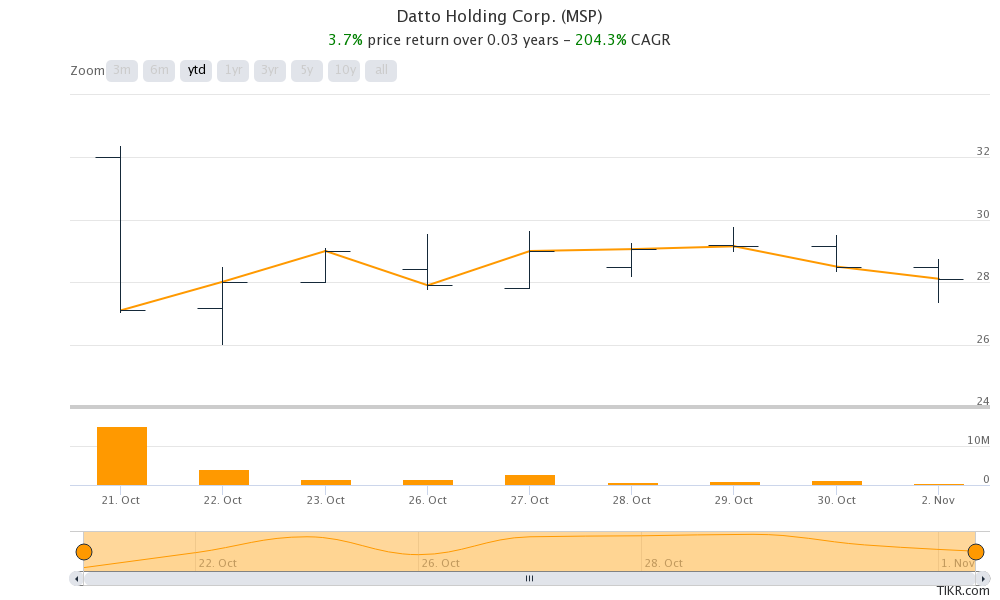Datto (NYSE:MSP) debuted on the markets on Oct. 21, closing at $27.10 having opened at $27 per share. Its first day of trading is representative of how it has fared on the markets since as the chart below shows. 
MSO has a few things going for it: even though growth is slowing, its margins and profitability have been improving, and it certainly has grown in value, proving the age-old adage that sometimes growth can be debilitating to value.
Yet, its lack of razzmatazz growth rates has not been offset enough by the margin and profitability improvements. Profitability is razor-thin, and from a capital cycle perspective, it lacks market strength in a hypercompetitive market.
A Vicious Capital CycleIf we take MSP’s market opportunity at face value, they have an addressable market that will grow from $28 billion in 2019 to $61.39 billion in 2023, at a CAGR of 17%. So far, MSP has failed to grow at a rate reflective of its market opportunity. It is difficult to find a more challenging market. MSP counts 125,000 competitors globally, though admittedly, not all of them serve the small-to-medium business market. This reflects broader trends in supply, which have seen a 300% rise in competitors from 2015, leading to growth from 2.6 competitors per company to 9.7 today.
Businesses with over 250 competitors use an average of 124 SaaS applications, while companies with up to 10 employees use an average of 26 applications. It is clear that there are few barriers to entry and so the market faces a supply glut that will drive economic profits down to the cost of capital so that what benefits the businesses may confer on their clients will not be captured profit-wise by those businesses. It is impossible to have pricing power in an environment this fierce and the nature of the business precludes the emergence of network effects. We will see as we go along that MSP has so far failed to show any meaningful profitability.
MSP’s platform does not give it the kind of competitive advantages that lend one to believe it can defend what profitability it captures or indeed capture the massive growth opportunity ahead of it. When your revenues are slowing in a rapidly growing market, that does not suggest that your product fit is particularly good.
A look at any MSP return ratio demonstrates just how harsh the environment is and how little profit the company earns: returns on assets are 1.1% and returns on capital are 1.9%. MSP’s ROIC is woeful too: 1.71% for 2019, up from 0.41% in 2018. In one sense, it is true that MSP is improving its position in the competitive landscape, which shows us that the value of the business is rising and it is getting better at defending its profitability. Investing in businesses emerging from poor capital returns can be a winning strategy. However, it is still true that the firm does not have a perceivable moat that can give confidence that its nascent profitability will continue. Our confidence that MSP can construct a moat to defend its profitability is very low. Management has not yet shown the capital allocation skill required to give us faith that the future will be good to MSP.
Profitability, as we have stressed, is heavily threatened by the extreme competition of the industry, so from a capital cycle perspective, this is a dangerous bet to make.
MSP has an excuse for its slowing growth and one uses the word “excuse” in a non-pejorative sense: given that its clients are small-to-medium businesses, it is particularly affected by the slump in SMB businesses in which 94% of small businesses have seen their revenues decline, and where many have seen their revenues shrink. It is my estimation that this has also materially shrunk the addressable market. Though the world is undergoing a ramped up digital transformation in response to the crisis, it does not seem as if MSP has profited from that transformation. Under the Hood
A company such as MSP faces two key risks: downgrades and churn. Also, they may simply fail to gain new customers. In trying to capture the vitality of the business, its dollar based net retention rate is very helpful in understanding how much revenue a business is bringing in year-over-year from existing customers. A business ideally should have a dollar based net retention rate of at least 100-106% and MSP’s scales this hurdle with 115%. However, exceptional companies typically have dollar-based net retention rates of 120% and MSP is no exceptional company. Furthermore, this number is as subject to deterioration as it is to improve so we cannot assume that things will improve. The conservative thing is to assume that the figure will remain the same, possibly dropping due to difficulties related to the SMB market.
Revenues are up 18.4% year-over-year. Revenues for the first six months of the year were $215 million, 15.9% higher than the $249 million for the same period last year. Clearly, growth is slowing down, though it remains high.
Gross profitability is 0.18, which is some way away from the hurdle rate of 0.33 that distinguishes exceptional companies who are able to make high levels of profits. Gross profitability is, however, on the rise, having been 0.15 in 2018 and looking set to reach 0.2 in 2020.
As we have hinted at, profitability is growing. One sign of this is the appreciation of operating income margins from 0.02 in 2018 to 0.06 in 2019. The margins are relatively poor when measured against peers, whose median margins are 0.15 and whose average margins are 0.13. Given that operating income margins are highly persistent over 3-year periods we can presume that this trend will continue.
Free cash flow is on the rise, which is always a plus, but a glance at the numbers is not encouraging: it has risen from -$38.76 million in 2018 to -$26.99 million in 2019. The company neither generates any cash available for distribution for shareholders nor demonstrates the aggressive market-capturing that would make us ignore its negative free cash flow. Negative free cash flows here are a red flag.
Free cash flow yields tell a more precise story: at -0.5% they are both lower than 10-year Treasuries, and suggest that the economics of the business is unattractive: in order to sustain its various business operations, MSP must invest greater amounts of its razor-thin profits. When making sole-proprietorship investments, these are the kinds of questions one must ask oneself: are the economics of the business sound, is the competitive landscape favorable, can we capture market share aggressively? MSP fails to inspire confidence or excitement. Conclusion
One must commend a business that improves its profitability even as revenues decline and which can show a rise in capital allocation skill and ability to grow a moat, nevertheless, the competitive landscape that MSP operates under is fierce and MSP is not showing that it has the chops to win the war. We can only conclude that economic profits will not be meaningful and that MSP will exist in a state of perpetual fragility to new market entrants.
